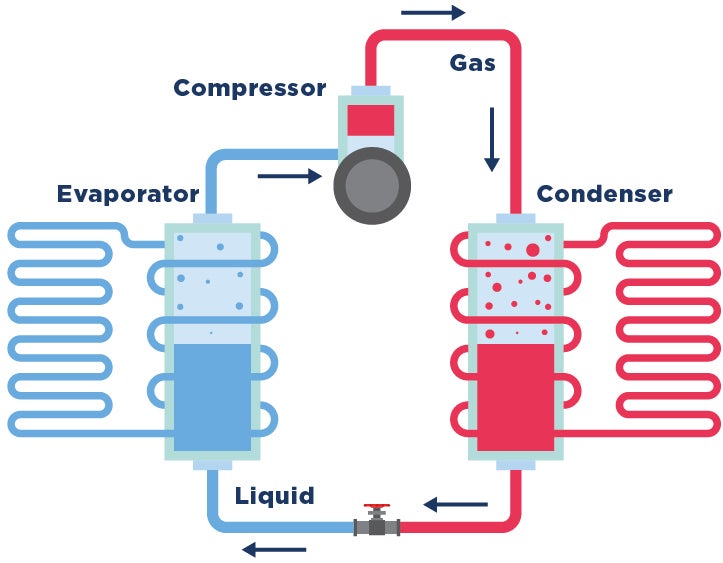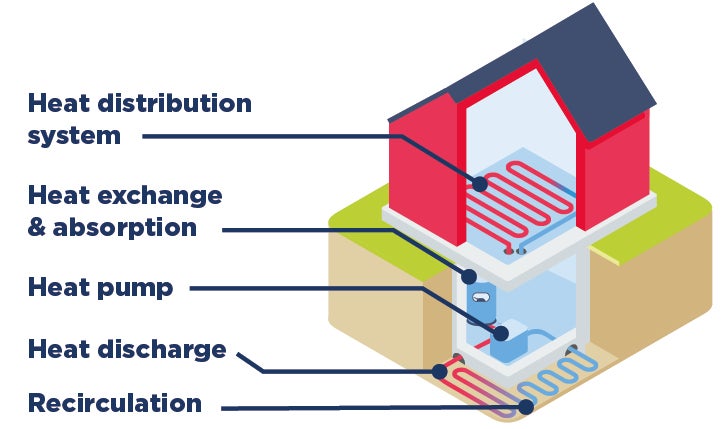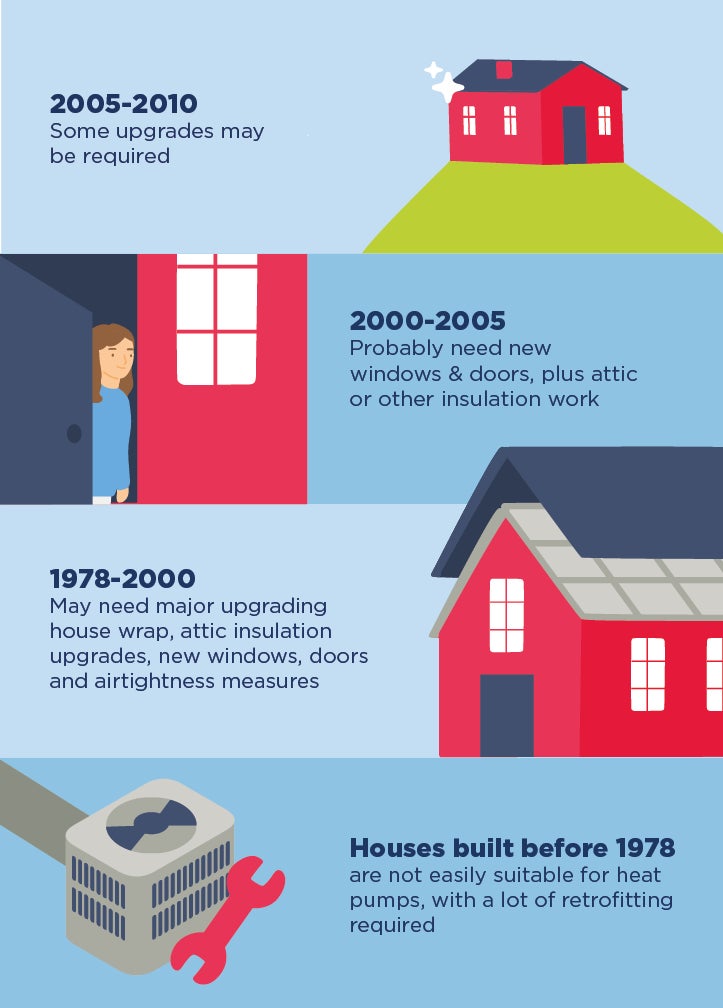Heat pumps - What they are and why you need one
Updated - March 2025
The ultimate guide to heat pumps in Ireland
Heat pumps are suitable for installation in most modern (post-1978) Irish homes and will handle your home's heating needs efficiently and effectively, helping you to save money on your energy bills due to their low maintenance and operating costs.

An increasingly common choice among Irish energy consumers, a heat pump reduces your home’s carbon footprint with zero on-site carbon emissions; a key benefit as we strive to reduce our reliance on fossil fuels for a more sustainable future. The Programme for Government and the Climate Action Plan set ambitious goals to reduce greenhouse gas emissions from buildings, including our homes, with targets to retrofit 500,000 homes to a Building Energy Rating of B2 and to install 400,000 heat pumps in existing and 280,000 new dwellings by 2030.
What is a heat pump?
It's a device that controls your home’s climate by distributing the heat that is already available in the air. In the colder times of year, it transfers heat from the outside environment and transfers it inside your home to provide warmth and comfort. A heat pump is essentially a smart and clean way to heat, purify, and dehumidify your home.

Heat pumps are part of a group of technologies that include HVAC (heating, ventilation, and air conditioning). These devices transfer heat and warmth from one place to another.
The primary energy source for a heat pump is electricity, however it has an excellent COP. The COP (Coefficient of Performance) is the ratio of electrical energy consumed by the heat pump to usable energy produced. Air to water heat pumps have a typical COP of between 3 & 4 which means it produces 3 to 4 units of heat for every unit of electricity consumed.
Heat pumps move thermal energy in opposite directions of heat flow by absorbing heat from warm spaces and realising it in a cold space. This means that a heat pump is an essential commodity for your home. The primary function of a heat pump within an energy efficient home is space heating via radiators, underfloor heating system, warm air convectors, and can also be used to heat water for daily needs.
The net benefit of acquiring a heat pump is creating a home that feels great and comfortable the whole year. It is a very smart concept that adds up to comfortable and energy-efficient climate control around your home and business.
Advantages of heat pumps
Like solar panels, there are several advantages of using heat pumps in your home. Some of these main benefits to Irish consumers include:
Heat pumps are cheaper than direct electric heaters, oil boilers and natural gas with the lowest running costs on the market. They are incredibly efficient and this brings greater long-term energy savings. Despite the fact that the initial cost of a groundwater heat pump can be high, this environment-friendly investment can help you save up in the long run.
Heat pumps produce no on-site carbon emissions, unlike conventional boiler-based heaters. When paired with renewable energy sources like solar PV panels, heat pumps are completely emissions-free. This means that heat pumps are effective in reducing your home’s carbon footprint.
Heat pumps can have a long life span of up to 50 years and the average lifespan is about 14 to 15 years. Heat pumps are exceptionally reliable and steady and are also safer than combustion-based heating systems.
Heat pumps increase your property value. A well-designed heat pump system installed within a smart home and maintained by a trusted, professional home energy specialist will increase the sale value of your home and other properties.
Other advantages include; they serve both heating and cooling functions, saves space because they don’t require fuel storage, requires no planning permission, and they are silent and unobtrusive.
What is the average cost of heat pumps?
For an average Irish home, an air source heat pump may cost about €12,000 - €18,000. This cost includes the equipment price and the installation fee. Such a heat pump has a single small fan and is suitable for a home up to around 200m2. A larger system that would be suitable for a home up to around 500m2 may cost between €15,000 and €23,000. The cost of a ground and water source heat pump is slightly higher than these prices.
These figures are just estimates, and the actual prices may vary from one installer to another. Thus, it is good to have room to room heat loss calculation before specifying the appropriate products for your home. An air-source heat pump unit alone should cost €3,000 - €12,000. Ground and water source heat pump systems should cost between €17,000 and €28,000. The average running cost of heat pumps ranges between €600 and €1000 per year.
Request a free consultationHow does a heat pump work?
Even though it sounds as if this device would generate heat like a furnace, that is not necessarily what it does. When a heat pump is being used to heat some space, it employs the basic working principle of refrigeration cycle used by an air conditioner or a fridge. However, it works in the opposite direction of releasing heat into the conditioned space rather than the surrounding environment.

Even in cold temperatures, there is still some heat available in the surrounding air and modern heat pumps can work effectively at temperatures as low as -20degC. The heat pump refrigerant absorbs the heat from the surrounding air and compresses it. The compression process generates energy and makes the refrigerant hotter and sends it to a coil installed inside the heat pump. The coil heats up from the refrigerant passing through it and conditions the air as it’s blown along the coil. This air absorbs the heat from the coil; the refrigerant inside the coil loses heat to the coil and air. The refrigerant cools and is sent back to absorb heat once again from the surrounding space.
The heated air is then used to condition your home and make it as comfortable as possible. The heat pump is configured in a way that you can control the levels of warmth around your home. This process can work in reverse whereby a heat pump can heat or cool the house as desired.
Heat pump installation
Ready to upgrade your home's heating system? You can now register for a heat pump installation with Bord Gáis Energy. From €4,999**
- All installations come with a 5-year warranty*
- All Installers are SEAI registered
- Reduce your heating bills by improving your energy efficiency
- Support the environment by reducing your greenhouse gas emissions
** This figure includes SEAI grant but additional costs may apply
* Installation and warranty Terms and Conditions apply.
More informationDifferent parts of a heat pump
The typical design of a heat pump usually involves four main components. These components include a condenser, an expansion valve, an evaporator, and a compressor. As stated above, heat transfer takes place via a chemical component known as a refrigerant. Each part has its main function, and it's vital for the proper operation of a heat pump. Each component functions as follows:
A condenser is widely known as a unit that condenses a substance from its gaseous form to its liquid state through a cooling process. In heat pump systems, the refrigerant acts as the condenser.
The latent heat released during the cooling process is transferred to the surrounding air or water by a coil, as explained above. Heat is released to water when a heat pump operates as a water heater. Condensers are manufactured in different designs and sizes depending on the size and application of a heat pump.
The expansion valve acts as the pressure-reducing device. When the high-pressure and medium-temperature refrigerant enters the expansion valve, its pressure and temperature are well-regulated to meet the desired levels.
The common expansion valve used in heat pumps is the copper capillary tube. The refrigerant then leaves the expansion valve at low pressure and temperature. It leaves partially in a liquid state and partially in a gaseous state. This process is important to ensure that the heat pump does not overheat.
An evaporator can either be outside or inside a coil depending on the heat pump’s mode of operation. In the winter, an evaporator is usually located outside the room and exposed to the atmosphere at very low temperatures. In the summer, the indoor unit’s coil acts as the evaporator. The evaporator is made of copper coil just like the condenser.
During cold weather, low-pressure and temperature refrigerant enter the evaporator coil, and the coil's temperature reduces below atmospheric temperature. Since the refrigerant temperature is lower than the outside temperature, it absorbs heat from the atmosphere. A fan is used to facilitate this process, and the heat generated is used to heat a home’s indoor air.
During the summer, the refrigerant's cold and low-pressure liquid-gaseous mixture evaporates while absorbing heat from the passing indoor air. The refrigerant then travels to the compressor to release the heat. Consequently, the inside air is cooled as it loses heat to the refrigerant. This means that your home is kept within your desired room temperature all the time.
The compressor is usually used to compress the refrigerant in order to achieve the desired pressure and temperatures. There are various types of compressors, such as centrifugal, screw, reciprocating, and scroll compressors. In some cases, a compressor pumps the refrigerant between two heat exchanger coils. In one coil, the refrigerant is evaporated at low pressure and absorbs heat from its surrounding. The refrigerant is then compressed as it moves to the other coil and condenses at high pressure.
Different types of heat pump
Depending on the type of heat required, there are different varieties of heat pumps with varying working principles, functionality, and application. Different pumps draw heat from different sources, such as air, water, ground/geothermal energy. The generated heat is then distributed via radiators, underfloor heating, or the warm air units.
Differing pumps also have different costs depending on their functionality. Some types of heat pumps include the following;
Air source heat pumps

These are heat pumps that provide heating by moving thermal energy from outside air to the inside air. Outdoor air is a universal heat source and sink medium for heat pumps and is widely utilised in residential and light commercial systems. There are two types of air-source heat pumps; air to air heat pumps and air to water heat pumps.
Air to air heat pump systems usually distribute the air via air units. Air to air heat pumps systems do not provide hot water. This is the most common type and is mainly used in commercial application. The heat is transferred from the outside air to the inside air. In this particular system, one heat exchanger usually operates as the evaporator and another one as the condenser.
Air to water heat pumps are by far the most popular heat pump on the market in Ireland at the moment, they usually transfer heat to a heating circuit or a tank of hot water. Heat is also distributed via radiators and underfloor heating floor heating is the most widely adopted and efficient application of air to water heat pumps in new homes while older homes upgrading to a heat pump may use existing radiators or upgrade to more efficient aluminium radiators. These heat pumps can also transfer heat to a domestic hot water tank for use in showers as well as hot water taps of your home. However, groundwater heat pumps are known to be more efficient than air-water heat pumps because energy from the ground is unaffected by weather conditions.
Ground source and water source heat pumps

Ground source and water source heat pumps (also known as a geothermal heat pump because energy is derived from below the earth surface) are less common than the air source ones. Heat is usually drawn from the ground via collector pipework and transferred to the installed heat pump. Ground water heat pumps are known to be more efficient than air-water heat pumps because energy from the ground is unaffected by weather conditions.
Water source heat pumps systems usually utilise open waters (lakes, rivers, or streams) to generate the required heat. While water source heat pumps may have extra complexity and cost higher than the air source heat pump systems, they perform more consistently than the air source heat pumps all year round.
What the experts say
SEAI grants for heat pumps
The Irish Government, through the Sustainable Energy Authority of Ireland (SEAI), offers financial incentives to make heat pump installation more affordable.
To determine whether your home is eligible for government funding and grant support for domestic heat pumps, it’s important to be mindful of the need for older homes to have a technical BER assessment carried out.
To qualify for a full grant of up to €6500, your house must have a HLI (Heat Loss Indicator) of <2 and be built before 2011.
Here’s a quick breakdown of the grant amounts available:
Heat pump typeHeat pump type | Grant amount (€)Grant amount (€) |
Heat pump typeAir-to-water heat pump | Grant amount (€)€6,500 |
Heat pump typeGround source heat pump | Grant amount (€)€6,500 |
Heat pump typeWater-to-water heat pump | Grant amount (€)€4,500 |
Heat pump typeExhaust air heat pump | Grant amount (€)€3,500 |
Grant information is valid as of March 2025. See seai.ie for more details.
To qualify for a grant, homeowners must:
- Own a home built before 2021.
- Upgrade home insulation where required to meet the heat pump’s performance needs.
- Use an SEAI-registered contractor for installation.
- Home Energy Assessment
A pre-installation assessment can help ensure your home is heat pump-ready. Grants for energy assessments are also available to reduce upfront costs further. - One-Stop Shop Scheme
Bord Gáis Energy's One Stop Shop offers streamlined services for those looking to combine heat pump installation with other energy-saving measures, such as wall and attic insulation or solar panels.
To qualify for a full grant of up to €6500, your house must have a HLI (Heat Loss Indicator) of <2 and be built before 2011.
For houses built between:

It is also our experience that most central heating systems piping and rads need to be upgraded to work efficiently at lower temperatures which adds significantly to costs.
Example cost breakdown
- Total cost of Air-to-Water Heat Pump: €12,000.
- Grant received: €6,500.
- Homeowner’s cost: €5,500.
Grants significantly lower the barrier to entry, making it easier for Irish households to transition to this energy-efficient technology while enjoying long-term savings.
Learn about grantsGovernment support scheme for commercial renewable heat systems
For non-domestic heat users, the Support Scheme for Renewable Heat (SSRH) is Ireland's government-funded initiative that has been designed to increase the amount of energy generated from renewable sources in the heat sector. This scheme is open to commercial, industrial, agricultural, district heating, public sector, and other businesses. Even though this scheme may not be applicable for your home heat needs, you can utilise the opportunity in your home-based business or other commercial applications.
The SSRH supports an installation grant and also offers support to an ongoing operation. For you to qualify for the support, you must meet some eligibility criteria;
- The proposed heat use should be eligible as well as adhere to the verified energy efficiency criteria.
- Heat generating technologies and project installations should comply with the Building Regulations, Construction Products Regulations, EN standards, technology standards, and the air quality standards as relates to emissions.
- Designers and installers should be competent to carry out heat systems work.
- The recipient of payments should meet tax clearance requirements.
Therefore, the Support Scheme for Renewable Heat is a good option for your commercial heat requirements and other covered sectors.
Heat pump service and repair
Is your heat pump in need of maintenance? Our team of accredited engineers are on hand to inspect, test, service and repair your system.
Book a heat pump service Book a heat pump repairSustainability hub
Sustainable energy is no fad - it's very much the future. So embrace it with our expert advice and services.
Beginner's guide to solar
Find out all you need to know about solar energy with our comprehensive beginner's guide.
Smart home guide
Discover how smart home technology can help you save energy, enhance comfort, and simplify your daily routine.